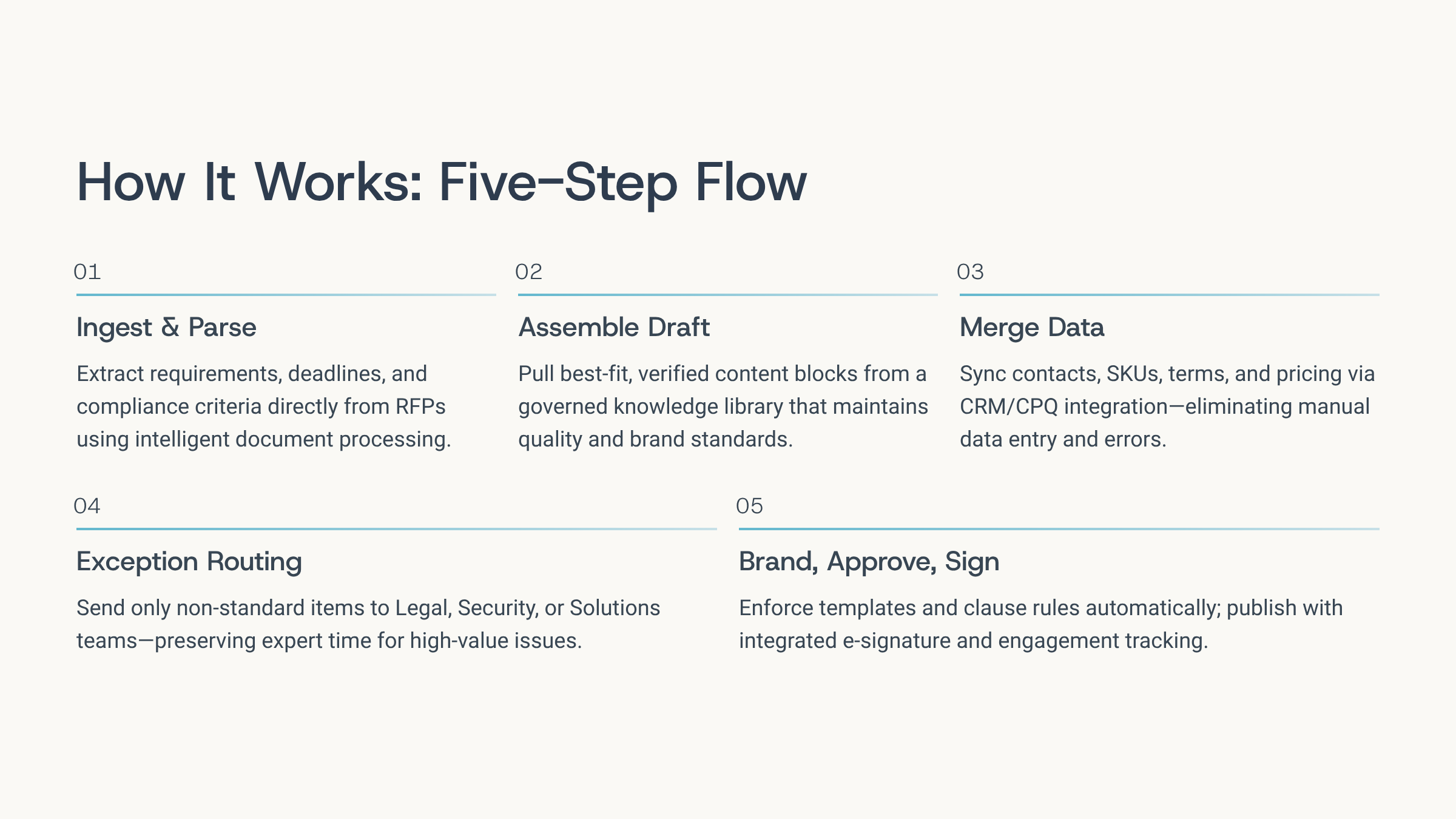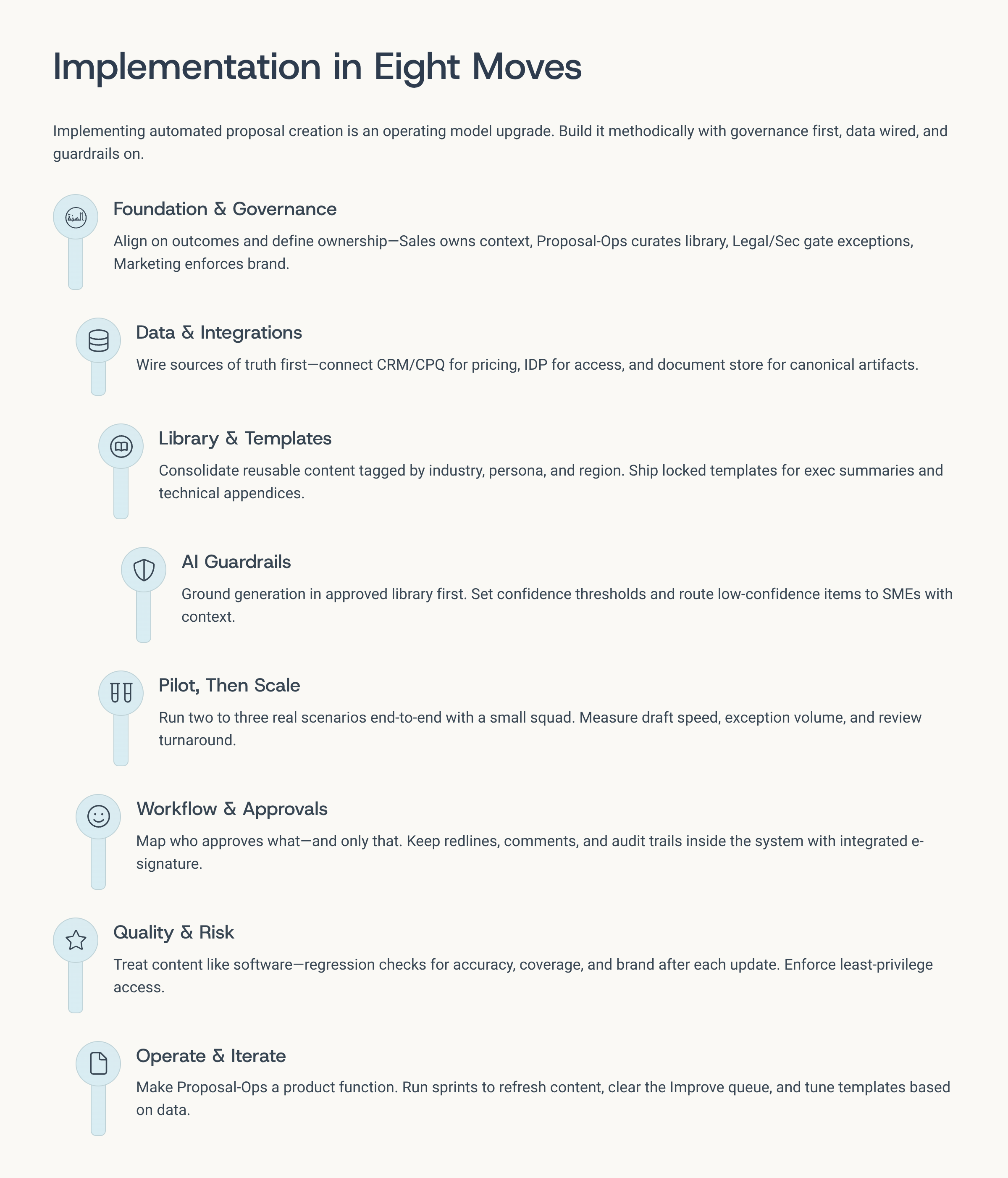Automated Proposal Generator: Faster Drafts, Cleaner Approvals, Stronger Wins
Article written by
Kate Williams

INSIDE THE ARTICLE
SHARE THIS ARTICLE
Summary
Still copy-pasting old proposals? That’s costing you deals. This post breaks down the chaos of manual proposal writing and shows how AI-powered automation transforms speed, quality, and consistency. The challenges, solutions, implementation tips, and what features actually matter—it's all here. If your team’s still stuck formatting at midnight, it’s time to rethink your stack.
Blank proposals drain time before writing even begins—chasing the latest security language, fixing formatting, and pasting boilerplate that no longer fits. An automated proposal generator changes that. It provides the blueprint, materials, and crew on demand: approved answers, consistent layouts, and governed workflows that turn repeat work into repeatable wins.
This blog explains what an automated proposal generator is, how proposal automation works under the hood, and how teams move from “another RFP” to “draft in minutes, approvals on rails.” We’ll define the core components, highlight key differences from generic document tools, outline common fixes and features, and close with the benefits and an implementation path for reliable, compliant RFP responses at scale.
What Is Automated Proposal Generation?
Before you evaluate tools, align on the definition. Automated proposal generation is a governed, AI-assisted workflow that transforms raw deal inputs—RFPs, opportunity notes, price books, past proposals—into a polished, on-brand, compliant proposal with minimal manual effort. Instead of starting from a blank page, the system ingests requirements, selects verified content, personalizes copy and pricing, and orchestrates reviews, approvals, and delivery—end to end. If that’s the “what,” the next section captures the essentials at a glance.
Key Facts in Snippets
- Purpose: Reduce time-to-first-draft and improve accuracy/consistency at scale.
- Inputs: RFP/PDF/email brief, CRM/CPQ data, approved content blocks (security, SLAs, case studies).
- Engine: AI parsing + content rules + role-based approvals + audit trails.
- Outputs: Web/PDF proposals with correct pricing, clauses, branding, and engagement analytics.
- Outcomes: Drafts in minutes, fewer redlines, higher compliance, and consistent win messaging.
Now that the basics are clear, here’s how it actually moves from input to signed proposal.
How It Works (5-Step Flow)
- Ingest & Parse: Extract requirements, deadlines, and compliance criteria from RFPs.
- Assemble Draft: Pull best-fit, verified blocks from a governed knowledge library.
- Merge Data: Sync contacts, SKUs, terms, and pricing via CRM/CPQ—no retyping.
- Exception Routing: Send only non-standard items to Legal/Security/Solutions.
- Brand, Approve, Sign: Enforce templates and clause rules; publish with e-signature and tracking.

Those steps run on specific building blocks. Let’s outline the core components that make the flow reliable.
Core Components
- Verified Content Library: Company overview, security posture, SLAs, ROI tables, case studies, and competitive notes.
- Parsing & Gap-Check: Map questions → answers; flag low-confidence gaps for SME review.
- Governance & Controls: Owners, review cadences, expiries, permissions, approval workflows, and audit logs.
- Integrations: CRM, CPQ, IDP/SSO, e-signature, storage, BI/analytics.
With the foundations in place, here’s how this differs from traditional “proposal software.”
Why Is It Different From “Proposal Software”?
- Compose vs. Orchestrate: It's not just writing; it decides, assembles, and routes with guardrails.
- Personalization at Scale: Industry/role-aware proof points without boilerplate fatigue.
- Continuous Learning: Engagement and win/loss data improve future drafts automatically.
Difference is useful, but impact matters most. Next, we map common failure points to specific fixes.
How Automated Proposal Generation Solves Proposal-Creation Challenges
Proposal work breaks down in the same places—blank pages, version chaos, stale answers, missed clauses, pricing errors, and never-ending redlines. You don’t need more heroics; you need a system that removes failure points by design. Automated proposal generation does exactly that: it standardizes what should be standard, flags what needs expertise, and accelerates everything in between. Below is a practical map of common pitfalls and how automation solves each one—so your team ships faster without sacrificing accuracy, brand, or compliance.
1) “Blank-page” starts → Auto-assembled first drafts
Pain: Rebuilding the same sections from scratch wastes hours and invites inconsistency.
Fix: The system assembles a first draft in minutes from a governed content library (company overview, security, SLAs, ROI, case studies) and maps RFP questions → best answers using AI.
Impact: Faster time-to-first-draft, less cognitive load, and consistent structure across teams.
2) Version chaos → Single workspace with governance
Pain: Redlines scattered across Docs, email, and Slack cause rework and missed edits.
Fix: Centralized workspace with role-based permissions, approval workflows, and audit logs (who changed what, when, and why).
Impact: Fewer conflicts, clean history, and audit-ready collaboration.
3) Stale or conflicting content → Verified, owner-maintained library
Pain: Teams copy outdated paragraphs (old pricing, retired features, legacy logos).
Fix: Content owners, review cadences and expiry rules keep blocks current; low-confidence or conflicting entries are flagged for improvement before reuse.
Impact: Reduced risk, consistent messaging, and higher trust with buyers.
4) Missed requirements → Parsing + gap-checks
Pain: Hidden clauses in long RFPs slip through, triggering last-minute scrambles.
Fix: AI parsing extracts requirements and builds a coverage matrix; gap checks flag anything not yet addressed.
Impact: Fewer defects, fewer late-night fixes, and a stronger compliance posture.
5) Slow, error-prone pricing → CRM/CPQ merge
Pain: Manual pricing and SKUs lead to typos, wrong terms, or discount leakage.
Fix: Live CRM/CPQ sync pulls contacts, configurations, SKUs, quantities, and approved discounts directly into the draft.
Impact: Accurate pricing on the first pass, faster approvals, and less finance rework.
6) Bottlenecked reviews → Exception-only routing
Pain: Legal, Security, and Solutions get dragged into every proposal, even for standard content.
Fix: Exception routing sends only non-standard clauses and edge cases to SMEs; everything else flows on rails.
Impact: SME time is preserved for high-value issues; cycle times shrink.
7) Brand drift & formatting thrash → Locked templates & tokens
Pain: Fonts, headers, and visuals change by author; decks don’t match the site.
Fix: Brand templates, style tokens, and clause rules standardize output (web/PDF) and prevent off-brand edits.
Impact: Every proposal looks and reads on-brand—no last-mile formatting marathons.
8) Boilerplate fatigue → Personalization at scale
Pain: Under pressure, teams paste generic proof points that don’t land.
Fix: System selects industry/role-relevant proof, ROI frames, and case studies; the tone adapts for execs vs. technical reviewers.
Impact: Human-sounding proposals that resonate—without adding hours.
9) Limited visibility after send → Engagement analytics
Pain: Reps don’t know who opened the proposal or which sections got attention.
Fix: Open/dwell/section heatmaps and alerts trigger targeted follow-ups; win/loss outcomes feed learning back to the library.
Impact: Smarter next steps and continuous content improvement.
10) Compliance anxiety → Controls, audit, and data residency
Pain: Unclear ownership and uncontrolled edits create compliance risk.
Fix: Approvals, immutable logs, role scopes, and residency settings (plus SSO/IDP) keep content and access under control.
Impact: Lower legal/security risk with evidence for audits.
Quick Before/After Automated Proposal Generator Implementation
Challenge | Automation Solution | Outcome |
|---|---|---|
Blank page & duplication | Auto-draft from verified blocks | Drafts in minutes |
Version chaos | Central workspace + audit logs | Clean history, fewer errors |
Stale content | Owners, expiries, confidence flags | Current, consistent answers |
Missed requirements | AI parsing + gap-check matrix | Fewer defects, less rework |
Pricing mistakes | CRM/CPQ merge | Accurate pricing, faster approval |
SME overload | Exception-only routing | Shorter cycles, focused expertise |
Brand drift | Locked templates/tokens | On-brand every time |
Generic copy | Industry/role personalization | Higher relevance, better win-rate signals |
No engagement data | Section heatmaps & alerts | Targeted follow-ups |
Compliance risk | Permissions, approvals, logs | Audit-ready governance |
With the problems and fixes mapped, let’s codify the few features that actually matter.
Key Features of an Automated Proposal Generator
You don’t need “more features.” You need the right ones. These are the capabilities that stop blank pages, stale answers, and redline pileups—so your team ships faster, cleaner, and on-brand every time.
Pillar 1: Intake & Understanding
Goal: Turn messy inputs into a structured brief.
Includes: RFP/PDF/email ingestion, requirement extraction, and compliance matrix.
Why it matters: Eliminates manual matrices and missed clauses.
Evaluate with:
- Can it detect sections/tables/attachments?
- Does it output a requirement coverage view (gap check)?
Pillar 2: Content Source of Truth
Goal: Reuse the best, verified answers—safely.
Includes: Governed content library (owners, review cadences, expiries), de-duplication, and flagged/low-confidence queue.
Why it matters: Prevents stale or conflicting copy; enforces brand and accuracy.
Evaluate with:
- Content health dashboard? Version history?
- Role-based access and approval states?
Pillar 3: AI Assembly & Personalization
Goal: First draft in minutes that still reads human.
Includes: Question→answer mapping, LLM guardrails, confidence scores, tone adaptation, industry/role-aware proof points, and case studies.
Why it matters: Kills blank-page tax without boilerplate fatigue.
Evaluate with:
- Source citations & temperature controls?
- Preset prompts/styles per segment (CFO, security, technical)?
Pillar 4: Commercial Accuracy (CRM/CPQ Merge)
Goal: Get pricing, SKUs, terms right the first time.
Includes: Live CRM/CPQ sync, discount rules, tax/region logic, and renewal handling.
Why it matters: Reduces finance rework; accelerates approvals.
Evaluate with:
- Field-level mapping and validation?
- Support for complex bundles/configs?
Pillar 5: Exception-Only Collaboration
Goal: Involve experts only where they add value.
Includes: Routing rules by clause/risk, SLA timers, assignees, reminders, and tracked changes.
Why it matters: Shortens cycles; reduces SME burnout.
Evaluate with:
- Can routing be rule-based (jurisdiction, deal size, risk)?
- Clear audit of who changed what, when, and why?
Pillar 6: Brand & Compliance Controls
Goal: Look on-brand and stay compliant every time.
Includes: Templates, style tokens, clause libraries, deviation approvals, and watermarking.
Why it matters: No last-mile formatting marathons; audit-ready outputs.
Evaluate with:
- Template locking and clause rule enforcement?
- Region/L10n variations (e.g., data residency, legal terms)?
Pillar 7: Output, Signature & Delivery
Goal: Ship proposals that can close.
Includes: Web/PDF output, e-signature, optional payments, and clause manifest/export.
Why it matters: Fewer tools; faster time-to-close.
Evaluate with:
- Multi-format publishing and redline-ready exports?
- DocuSign/Adobe/HelloSign integrations
Pillar 8: Engagement Intelligence
Goal: Know what lands—and act fast.
Includes: Opens, dwell, section-level heatmaps, recipient journeys, and CRM write-back.
Why it matters: Precision follow-ups; content that improves with evidence.
Evaluate with:
- Per-section analytics and alerts?
- Closed-loop reporting into CRM/BI?
Pillar 9: Continuous Learning Loop
Goal: Each proposal makes the next one better.
Includes: A/B testing, content performance scoring, auto-archiving of low performers, and promotion of winners.
Why it matters: Win themes get codified; mediocre blocks fade out.
Evaluate with:
- Can we rank blocks by win-rate/engagement?
- Automated suggestions for replacements?
Pillar 10: Enterprise Security & Admin
Goal: Be vendor-review ready.
Includes: SSO/SCIM, RBAC, encryption in transit/at rest, retention policies, region pinning, and immutable logs.
Why it matters: Reduces legal/security risk; speeds up security reviews.
Evaluate with:
- Fine-grained permissions and least-privilege roles?
- Region selection and data retention controls?
Pillar 11: Extensibility & Ecosystem Fit
Goal: Play nicely with your stack.
Includes: REST/GraphQL APIs, event webhooks, SDKs, and connectors (CRM, CPQ, CLM, storage, BI, chat).
Why it matters: No swivel-chair work; cleaner RevOps reporting.
Evaluate with:
- Sandbox and rate limits?
- Reliable eventing for downstream automation?
Don’t boil the ocean. Pick one deal type, turn on content governance + CRM/CPQ sync + exception routing, and track four numbers: time-to-first-draft, SME hours, defects, and time-to-sign. If they drop, you’ve found your system—now scale it.
10 Benefits of Automated Proposal Creation
Automated proposal creation replaces copy-paste chaos with a governed, data-driven process that drafts, personalizes, and routes proposals end-to-end. Instead of spending hours formatting, searching for “the latest” language, or chasing approvals across email threads, teams move from request to ready-to-send in a single, auditable flow. The payoff isn’t just speed; it’s consistency, lower risk, and clearer ownership at every step. The points below expand on what that looks like in practice.
1. Velocity Without the Mess
With an approved library and CRM/CPQ data wired in, your “blank page” becomes a near-final draft in minutes. Sellers shape the narrative and follow-up strategy; leaders get predictable turnarounds and fewer fire drills.
2. Consistency That Builds Trust
A governed answer hub standardizes product descriptions, security positions, SLAs, and case studies, so every document reinforces the same story—and makes it easier for prospects to say yes.
3. Accuracy Through Governance
Owners, review cadences, and expiry dates prevent “zombie paragraphs.” The system pulls approved blocks and flags low-confidence content so experts focus on nuance, not rework.
4. Compliance on Rails
Pricing, legal, and security approvals live inside the workflow. Clear context and audit trails speed sign-off and de-risk enterprise deals.
5. Personalization at Scale
Tagging proof points and stories by industry and persona yields proposals that feel intentionally crafted—executive-ready or technically deep—without extra hours.
6. Expert Time Where It Counts
Exception routing reserves SME attention for non-standard or low-confidence items, protecting momentum while raising quality.
7. Stronger Brand Control
Locked templates and styling tokens keep deliverables on-brand, so design teams improve assets instead of fixing layouts.
8. Analytics That Compound Learning
Section heatmaps and win/loss signals feed the library. High performers become defaults; weaker modules get refined or retired.
9. Seamless Handoffs to Close
When e-signature and delivery are in the same flow, “approved draft” becomes “signed deal” with fewer tools and fewer steps.
10. Happier Sellers, Clearer Leadership
Less admin drag lifts morale and selling time; leadership gets cleaner forecasts and fewer escalations.
Automated proposal creation isn’t just a speed play—it’s a precision framework that protects truth, brand, and compliance while freeing experts to do expert work.
The Role of AI in Automated Proposal Generation
Here’s a glimpse into how AI actually powers proposal generation—so the features work predictably at enterprise scale.
- Ingest & Normalize: OCR + layout parsing turn PDFs/emails into structured objects (Requirement, Constraint, Deliverable, Question); dedupe/canonicalize variants.
- RAG Mapping: Embed each requirement → retrieve governed blocks (answers, security, SLAs, cases) by similarity, metadata, freshness; LLM drafts with citations/IDs.
- Policy Guardrails: Apply allow/deny lists, clause libraries, term normalization; flag risky constructs; log who/what/when/why.
- CRM/CPQ Fusion: Pull SKUs/pricing/approvals via functions; render numbers via deterministic templates; LLM handles narrative around them.
- Draft Assembly: Compose modular sections; keep tone/reading level consistent; maintain cross-refs and numbering.
- Confidence & Routing: Score each span; auto-route low-confidence/non-standard items to the right SME with sources and policy checks.
- Smart Personalization: Use industry/role/geo/deal stage + micro-blocks to tailor without boilerplate drift.
- Brand & Readability: Enforce voice/terms/templates; rewrite for scanability without changing approved facts.
- Collab & Versioning: Block-level diffs, re-validation, single audit trail; promote improved passages to the governed library.
- Delivery & Learning: Track section engagement; update content scores; demote weak blocks to “Improve,” promote winners.
- Security by Design: Least-privilege, tenant isolation, encryption, residency/retention policies; retrieval-only on sensitive docs.
- Resilience: Safe fallbacks on thin sources/timeouts; health checks for drift, freshness, and policy coverage.
With the mechanics clear, here’s the fastest way to roll it out—govern first, wire data, set guardrails, pilot small, then scale.
Implementation Framework
Implementing automated proposal creation isn’t a tooling swap—it’s an operating model upgrade. Treat it like a product launch inside your org: define outcomes, wire sources of truth, and codify governance before content hits the system. With a tight pilot, locked templates, and AI guardrails, you move from heroic one-offs to a predictable, compliant engine that drafts what’s known and escalates only what’s novel. Build it in eight moves:
1) Foundation & Governance
Align on outcomes (faster drafts, fewer bottlenecks, and brand/compliance by default). Define phase-one scope and ownership. Stand up a lightweight RACI: Sales owns context, Proposal-Ops curates the library, Legal/Sec gate exceptions, and Marketing enforces the brand. Governance precedes content—always.
2) Data & Integrations
Wire sources of truth first. Connect CRM/CPQ for pricing and product data, IDP for access, and your document store for canonical artifacts. Validate field mappings and approval paths in a sandbox.
3) Library & Templates
Consolidate real, reusable content (company, product, security, SLAs, implementation, case studies). Tag by industry/persona/region; version with owners and review dates. Ship locked templates (exec summary, technical appendix, commercials, security).
4) AI Guardrails
Ground generation in the approved library first, generative language second. Set confidence thresholds and route low-confidence/non-standard items to SMEs with context. Keep an “Improve” queue visible to close gaps fast.
5) Pilot, Then Scale
Run two or three real scenarios end-to-end with a small squad. Measure draft speed, exception volume, and review turnaround; fix taxonomy and gaps quickly. Roll out by segment or region.
6) Workflow & Approvals
Map who approves what—and only that. Keep redlines, comments, and audit trails inside the system. Tie e-signature (and payments if relevant) into the same path.
7) Quality & Risk
Treat content like software: regression checks for accuracy, coverage, brand, and formatting after each update. Enforce least-privilege access, log every change, and align retention/residency with regulations.
8) Operate & Iterate
Make Proposal-Ops a product function. Run sprints to refresh content, clear the Improve queue, and tune templates. Track leading indicators (draft time, exceptions, SLAs) and lagging indicators (acceptance, redline depth, section engagement).
Your north star is repeatability with control. When governance, data, and workflows work in sync, proposals stop consuming cycles and start compounding advantage. Keep improving the visible queue, measure speed and quality, and iterate in short sprints.

Wrapping Up
If there’s one idea to take with you, it’s this: automated proposal generation—powered by SparrowGenie—turns proposals from one-off heroics into a repeatable advantage. With SparrowGenie, you capture the ask, assemble a first draft from governed truth, personalize with real data, route only the edge cases, and ship on-brand with clean approvals—then learn from every send. The benefits compound: faster cycles without the mess, consistent messaging that earns trust, compliance embedded in the secure workflow, and analytics that sharpen the system over time. With a pragmatic implementation—governance first, data wired, guardrails on, pilot tight—you shift the team’s energy from formatting to persuading. That’s the win. If your next proposal needs to land with clarity, confidence, and zero chaos, SparrowGenie shows the path—one governed block, one clean approval, and one signed agreement at a time.
Ready to see how AI can transform your RFP process?
Product Marketing Manager at SurveySparrow
A writer by heart, and a marketer by trade with a passion to excel! I strive by the motto "Something New, Everyday"

